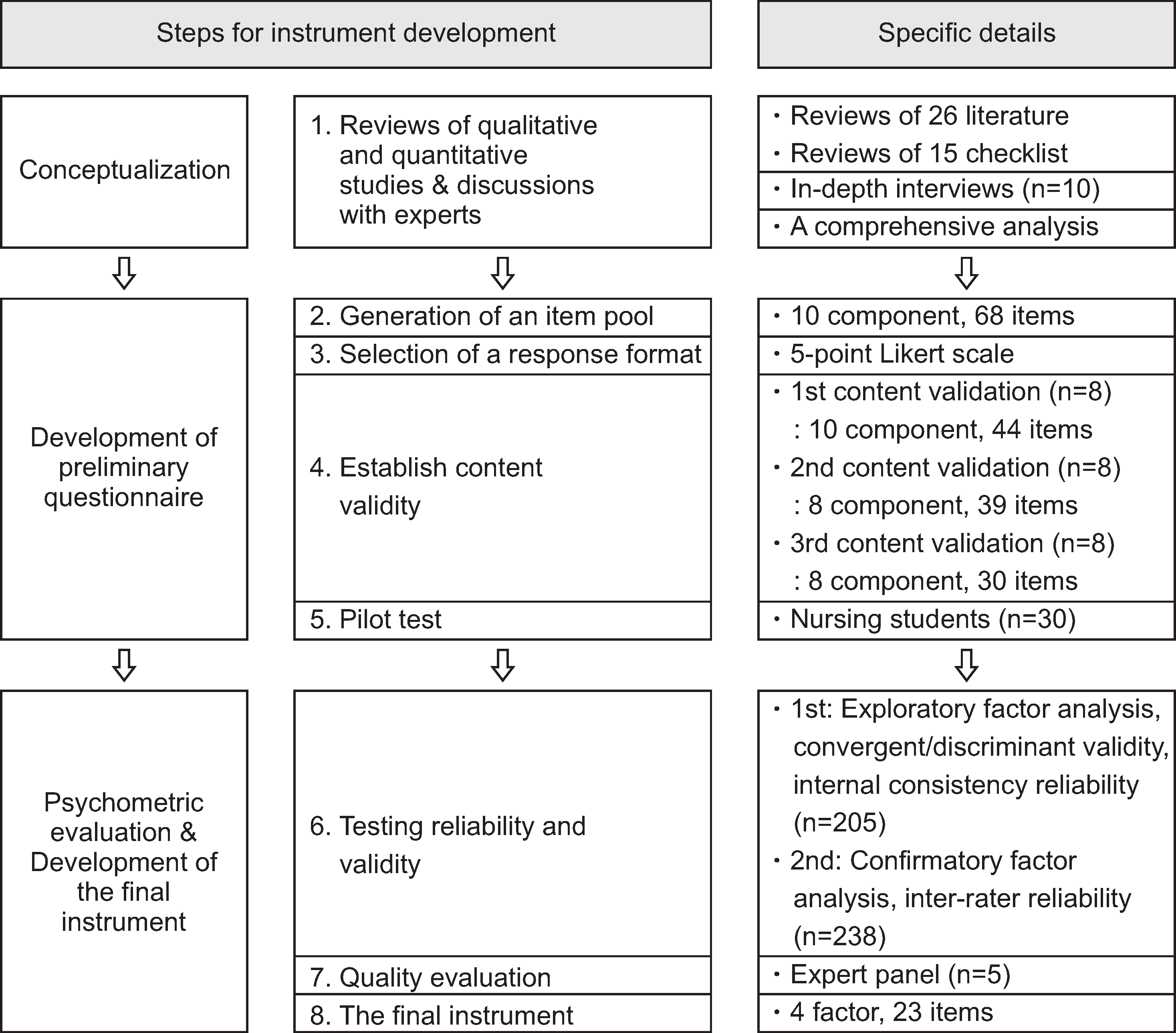Abstract
Purpose
The purpose of this study was to develop and establish the psychometric properties of a clinical nursing competency evaluation tool to be utilized by clinical preceptors.
Methods
The initial items were identified through in-depth literature review and field interviews based on a hybrid model. Content validation of the items was evaluated through three rounds of content validity testing. Participants were 34 clinical preceptors and 443 nursing students participating in clinical practice. Data were analyzed using exploratory and confirmatory factor analysis, convergence and discriminant validity, internal consistency and inter-rater reliability.
Results
The final scale consisted of 23 items and four factors, fundamental nursing skills performance, critical thinking skills based on the nursing process, basic nursing knowledge, and professional attitude; these factor explained 69.7% of the total variance. The analysis with multi-trait/multi-item matrix correlation coefficients yielded 100.0% and 95.7 % convergence and discriminant validity, respectively. Cronbach's alpha for the total items was .95. The four subscale model tested by confirmatory factor analysis was satisfactory. Inter-rater reliability ranged from .912 to .967.
References
1. McKown T, McKeon L, Webb S. Using quality and safety education for nurses to guide clinical teaching on a new dedicated education unit. Journal of Nursing Education. 2011; 50(12):706–710. https://doi.org/10.3928/01484834-20111017-03.

2. Song JH, Kim MW. Study on clinical education for nursing in hospitals in Korea. The Journal of Korean Academic Society of Nursing Education. 2013; 19(2):251–264. https://doi.org/10.5977/jkasne.2013.19.2.251.

3. Im EJ. Developing and testing an evaluation tool to measure clinical teaching. Korean Journal of Medical Education. 2011; 23(1):49–59. https://doi.org/10.3946/kjme.2011.23.1.49.

4. Bourbonnais FF, Langford S, Giannantonio L. Development of a clinical evaluation tool for baccalaureate nursing students. Nurse Education in Practice. 2008; 8(1):62–71. https://doi.org/10.1016/j.nepr.2007.06.005.

5. Msiska G, Smith P, Fawcett T, Munkhondya TM. Where is the grade coming from? Problems and challenges in evaluating the clinical performance of nursing students. Open Journal of Nursing. 2015; 5(5):470–481. https://doi.org/10.4236/ojn.2015.55050.

6. Bradshaw C, O’Connor M, Egan G, Tierney K, Butler MP, Fahy A, et al. Nursing students’ views of clinical competence assessment. British Journal of Nursing. 2012; 21(15):923–927. https://doi.org/10.12968/bjon.2012.21.15.923.

7. Kown IS, Seo YM. Nursing students’ needs for clinical nursing education. The Journal of Korean Academic Society of Nursing Education. 2012; 18(1):25–33. https://doi.org/10.5977/jkasne.2012.18.1.025.

8. Korean Accreditation Board of Nursing Education. Nursing education accreditation standards: Evaluation criteria and indicators [Internet]. Seoul: Korean Accreditation Board of Nursing Education;c2014. [cited 2016 Mar 21]. Available from:. http://www.kabon.or.kr/eng/kabon02/index02.php.
9. Sung MS, Jeong GH, Jang HJ. Development of clinical evalua- tion tool for nursing students. The Journal of Korean Academic Society of Nursing Education. 1998; 4(2):172–186.
10. Campbell B, Mackay G. Continuing competence: An Ontario nursing regulatory program that supports nurses and employers. Nursing Administration Quarterly. 2001; 25(2):22–30. https://doi.org/10.1097/00006216-200101000-00006.

11. Nam HH. Development of a clinical evaluation tool for nursing students [master’s thesis]. Seoul: University of Ewha;1996. p. 80–82.
12. Joo GE, Sohng KY. Development of nursing competence scale for graduating nursing students. Journal of Korean Public Health Nursing. 2014; 28(3):590–604. https://doi.org/10.5932/JKPHN.2014.28.3.590.

13. Lin CC, Wu CJ, Hsiao YC, Han CY, Hung CC. An exploratory factor analysis for developing and validating a scale of nursing students competence Instrument. Nurse Education Today. 2017; 50:87–91. https://doi.org/10.1016/j.nedt.2016.12.007.

14. Wangensteen S, Johansson IS, Nordström G. Nurse competence scale–psychometric testing in a Norwegian context. Nurse Education in Practice. 2015; 15(1):22–29. https://doi.org/10.1016/j.nepr.2014.11.007.
15. Lee KJ, Chang CJ, Hong SS. Development of clinical evaluation tool for nursing student. Journal of Korean Academy of Nursing Administration. 2001; 7(3):473–485.
16. DeVellis RF. Scale development: Theory and applications. 3rd ed. Los Angeles (CA): Sage Publications Inc.;2012. p. 42–60. 80-110.
17. Schwartz-Barcott D, Kim HS. An expansion and elaboration of the hybrid model of concept development. Rodgers BL, Knafl KA, editors. Concept Development in Nursing: Foundations, Technqiues, and Applications. 2nd ed. Philadelphia (PA): W.B. Saunders;2000. p. 129–159.
18. Spencer LM, Spencer SM. Competence at work: Models for superior performance models for superior performance. New York: John Wiley & Sons;1993. p. 3–15.
19. Lynn MR. Determination and quantification of content validity. Nursing Research. 1986; 35(6):382–386. https://doi.org/10.1097/00006199-198611000-00017.

20. Polit DF, Beck CT. Nursing research: Generating and assessing evidence for nursing practice. 8th ed. Philadelphia (PA): Lippincott Williams & Wilkins, Wolter Klwer;2008. p. 458–486.
21. Hinkin TR. A brief tutorial on the development of measures for use in survey questionnaires. Organizational Research Methods. 1998; 1(1):104–121. https://doi.org/10.1177/109442819800100106.

22. Anderson JC, Gerbing DW. Structural equation modeling in practice: A review and recommended two-step approach. Psychological Bulletin. 1988; 103(3):411–423. https://doi.org/10.1037/0033-2909.103.3.411.

23. Ware JE Jr, Gandek B. Methods for testing data quality, scaling assumptions, and reliability: The IQOLA Project approach. International Quality of Life Assessment. Journal of Clinical Epidemiology. 1998; 51(11):945–952. https://doi.org/10.1016/S0895-4356(98)00085-7.
24. Tabachnick BG, Fidell LS. Using multivariate statistics. Needham Heights (MA): Allyn & Bacon;2006. p. 607–675.
25. Landis JR, Koch GG. The measurement of observer agreement for categorical data. Biometrics. 1977; 33(1):159–174. https://doi.org/10.2307/2529310.

26. Kang H. A guide on the use of factor analysis in the assessment of construct validity. Journal of Korean Academy of Nursing. 2013; 43(5):587–594. https://doi.org/10.4040/jkan.2013.43.5.587.

27. Hair JF, Black WC, Babin BJ, Anderson RE. Multivariate data analysis. 7th ed. Upper Saddle River (NJ): Prentice Hall;2010. p. 609–732.
28. Skúladóttir H, Svavarsdóttir MH. Development and validation of a clinical assessment tool for nursing education (CAT-NE). Nurse Education in Practice. 2016; 20:31–38. https://doi.org/10.1016/j.nepr.2016.06.008.

29. Worthington RL, Whittaker TA. Scale development research a content analysis and recommendations for best practices. The Counseling Psychologist. 2006; 34(6):806–838. https://doi.org/10.1177/0011000006288127.
Table 1.
Exploratory Factor Analysis and Reliability (N=205)
Table 2.
Multi-Trait/Multi-Item Matrix Analysis (N=205)
Table 3.
Inter-Rater Reliability (N=76)




 PDF
PDF ePub
ePub Citation
Citation Print
Print



 XML Download
XML Download